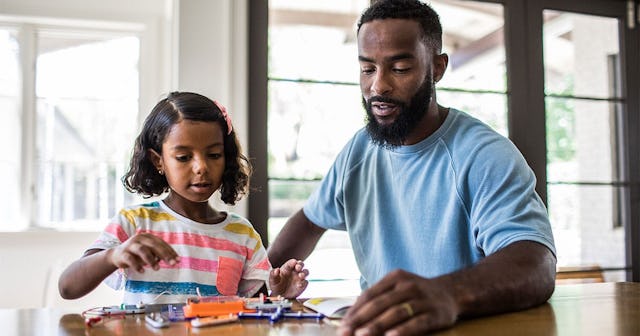Child-Directed Learning Is The Key To Stopping The 'School Battles'

Suddenly, you’re the teacher, teacher’s aide, lesson planner, disciplinarian, hall monitor, and lunch person — all at once. You may be overwhelmed. You may be panicked. You may be thinking, “How the hell am I going to get through all this work when my kids are freaking out about the coronavirus?” The answer is simple: you aren’t.
Many teachers had two days or even less to prepare for distance learning (I’m related to two of them). Some were sent home with packets from the district — packets that set unrealistic goals for parents to teach, and for children to learn, when they’re in an unstable environment. Enter child-directed learning. You know when you’re freaked out and you want comfort food? Your kid is off-kilter, and they want comfort learning. Child-directed learning can give them that comfort while still keeping up with some educational goals.
What is child-directed learning?
terri/Reshot
Child-directed learning is also called “student-centered learning.” According to ContinuED, which offers online credit for teachers, student-centered learning is “more of an interactive setting where students are constructing their own knowledge” and “looks a lot like play.” Edutopia says that in “self-directed learning programs” kids are far more engaged and learn at their own pace. Kids who learned this way at a school in Switzerland, they claim, “historically exhibited far lower levels of distress and anxiety compared to children in the regular school system.” Moreover, kids who went through this school report having had “a very happy childhood.”
Child-directed learning presumes that your kid wants to learn. Your child is a sponge that wants to soak up something. Your child is curious about something in this world. They do not have to be forced to learn. It may not be your choice for their education. Doesn’t matter. It’s their choice. That’s the point. They pick. That’s the point of child-directed learning.
When your kid picks, you’ll know it. What’s that thing that makes their eyes light up? What’s that thing they never shut up about? What are they always trying to show you, to drag you into? With my oldest, it’s Celtic myth and Dungeons and Dragons. My middle son? Amphibians of all stripes. My youngest? Video games of every kind, and high-level board games, often in modified forms (the type adults are supposed to play … and he’s six). That’s their thing. You found it.
RELATED: 12 Best Dragon Toys For Imaginative Play, From Realistic Beasts To Cuddly Friends
Okay. Now WTF do you do with it?
We’re stuck in social isolation, or I’d normally tell you to go to library and deluge them with books. But there’s another way to accomplish child-directed learning: the internet. YouTube, when monitored, has bucketloads of amazing information about pretty much everything. There are documentaries. There are websites. There are sites for teacher lesson plans and things you can order to help you. There are podcasts. My oldest loves Common Descent, a podcast about evolution (science) and Blurry Photos (social studies-ish), about mysterious and inexplicable phenomena.
My oldest builds accurate Greek temples out of LEGOs and measures them (social studies and math). He tells his brothers stories of myths (summary). He adds up how many days Demeter has to spend with Hades, or how long The Iliad lasts (math). He writes down his findings (writing). We let him read what he wants to — any and all reading counts in this classroom. They get science from the world around them — my husband, now a teacher, once had a foray into the discipline of field biology. We watch documentaries they choose. Need map skills for kids who like aliens? Let them track UFO sightings on the Mutual UFO Network website.
Basically, get creative. Give your kids the ideas, and let them run with it. You may have to help them in the beginning: they aren’t used to a schooling that lets them do, well, whatever they find interesting. Need help with math? Cooking counts, what with all those fractions. All this counts as child-directed learning. All this happens in my house on a regular basis. My kids are happy. They love child-directed learning.
What good does this all do?
Carly Kewley/Unsplash
Think hard about what you want your kid to emerge from this social distancing with. Think really hard. Do you want them to come out of it learning long division? Teachers will be doing massive reviews when school starts again. They won’t expect kids to have retained all the knowledge from those packets they sent home.
Do you want your kids to learn long division and stress? Or do you want your kids to emerge with a sense of resilience and strength, ready to meet challenges and soldier through adversity? Do you want them to know those important soft skills, like getting along with others in tight situations, keeping their temper in tough times, and helping out those who need it? Do you want them to maintain a love of learning, even if that means reading a college-level text about Bigfoot, or training the dog, learning about dog genetics via documentaries, and writing about it (science!).
I’ll pick door number two.
This is nothing new to us; we were doing child-directed learning from the time they started school. Yes, we sometimes have to force math. But my eight-year-old can pick up seemingly identical toads and identify their species. They can relay great summaries. They are happy and love to learn new things. They are curious. That’s enough for me. Maybe, in this time of stress and uncertainty, it’ll be enough for you, too.
This article was originally published on